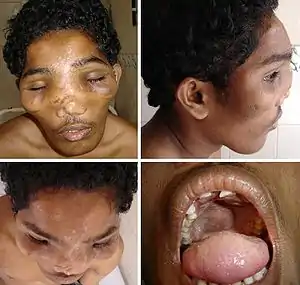Leontiasis ossea
Leontiasis ossea, also known as leontiasis, lion face or lion face syndrome, is a rare medical condition, characterized by an overgrowth of the facial and cranial bones. It is not a disease in itself, but a symptom of other diseases, including Paget's disease, fibrous dysplasia, hyperparathyroidism and renal osteodystrophy.
| Leontiasis ossea | |
|---|---|
 | |
| A 25-year-old man with leontiasis ossea as a complication of polyostotic fibrous dysplasia[1] |
The common form is that in which one or other maxilla is affected, its size progressively increasing, and thus encroaching on the cavities of the orbit, the mouth, the nose and its accessory sinuses. Exophthalmos gradually develops, going on later to a complete loss of sight due to compression of the optic nerve by the overgrowth of bone. There may also be interference with the nasal respiration and with the taking of food. In the somewhat less common form of this rare disease the overgrowth of bone affects all the cranial bones as well as those of the face, the senses being lost one by one and death finally resulting from cerebral pressure. There is no treatment other than exposing the overgrown bone, and chipping away pieces, or excising entirely where possible.
Great Sphinx
Surgeon Hutan Ashrafian from Imperial College London has analysed the Great Sphinx to identify that it may have represented an individual suffering from prognathism which may have been a reflection of a disease suffered by the sculpture's human inspiration. Furthermore, as the Sphinx represented a lion, the same person may have suffered from leontiasis ossea.[2][3]
See also
References
- Maramattom BV (2006). "Leontiasis ossea and post traumatic cervical cord contusion in polyostotic fibrous dysplasia". Head & Face Medicine. 2: 24. doi:10.1186/1746-160X-2-24. PMC 1562402. PMID 16911793.
- Ashrafian, Hutan. (2005). "The medical riddle of the Great Sphinx of Giza". J Endocrinol Invest. 28 (11): 866. doi:10.1007/bf03347583. PMID 16370572. S2CID 36752150.
- Galassi, Francesco M. (2014). "On the face and identity of the Great Sphinx of Giza: a medico-anthropological review". Shemu (The Quarterly Newsletter of the Egyptian Society of South Africa). 18 (3).
 This article incorporates text from a publication now in the public domain: Chisholm, Hugh, ed. (1911). "Leontiasis Ossea". Encyclopædia Britannica. 16 (11th ed.). Cambridge University Press. p. 455.
This article incorporates text from a publication now in the public domain: Chisholm, Hugh, ed. (1911). "Leontiasis Ossea". Encyclopædia Britannica. 16 (11th ed.). Cambridge University Press. p. 455.- Lee VS, Webb MS Jr, Martinez S, McKay CP, Leight GS Jr (April 1996). "Uremic leontiasis ossea: "bighead" disease in humans? Radiologic, clinical, and pathologic features". Radiology. 199 (1): 233–240. doi:10.1148/radiology.199.1.8633151. PMID 8633151.CS1 maint: multiple names: authors list (link)